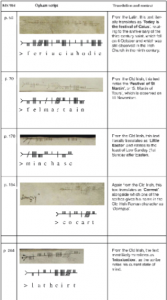Ogham gleanings from an Irish manuscript in the Swiss city of St Gallen
Published in Features, Issue 5 (September/October 2013), Medieval History (pre-1500), Volume 21The introduction of Christianity into Ireland in the fifth century also brought with it the common ecclesiastical language of Latin, which ultimately gave not only the new ecclesiastical classes but also the existing Aos Dána an effective system of writing based on the same Roman characters that are used today. Up to this time Ireland had a highly developed and well-established system of native learning that was primarily based on oral transmission, and although the rudimentary alphabet of Ogham was widely used on burial standing stones, the adoption of the Latin alphabet enabled the ancient Irish language to be more easily written down. With the earliest extant manuscript in the Irish language, Amra Choluim Chille, written in 597, Irish is the oldest surviving vernacular in north-western Europe.
The following centuries saw the development of an unrivalled tradition of ecclesiastical, and often secular, transcribing among a fervent and scholarly monastic scribal class, whose ‘Irish script style’ was influencing their Continental contemporaries by the seventh century. Along with the elaborate decoration of the texts, this unique style of the early Irish scribes included the surprisingly novel concept of inter-word spacing, which by the ninth century would spread throughout the rest of Europe, making the once fundamental scriptio continua characteristic of Latin a thing of the past.
St Columbanus and St Gall

Facsimiles, transliterations and translations of some of the marginalia from the ninth-century St Gall Priscian manuscript. (Codices Electronici Sangallenses/Virtual Manuscript Library of Switzerland)
Founded by St Comgall c. 552–9, Bangor Abbey (in present-day County Down) was one of many such monasteries that included a scriptorium. Its early students included St Columbanus and a contemporary young monk named Cellach (Latinised as Gallus). Taking with them manuscript copies of the Scriptures crafted in the ‘Irish script style’, St Columbanus and eleven other monks, accompanied by St Gall, set off in 589 for the Continent, where they laid the foundations for monasteries such as Annegray, Luxeuil, Fontaines and Würzburg. St Gall remained behind in the Steinach Valley when in 612 Columbanus and the other monks continued on to Bobbio. After St Gall’s death, the site of his hermitage and his tomb in the remote region became highly venerated, visited by generations of pilgrim monks from Ireland. By the early eighth century a monastery dedicated to St Gall had become established on this site, which over the following centuries further facilitated the increasing numbers of Irish visitors.
With a growing reputation as a centre of learning, the abbey soon became an established base for Irish monks, with one in particular, Marcellus, recorded as heading St Gall’s famed school from the mid-ninth century. It was during this period that the library gradually became home to the manuscripts of visiting and resident Irish monks, who brought with them their valuable texts as they travelled on the Continent, often between the now well-established ‘Irish’ monasteries, which themselves cultivated the art of copying and transcribing manuscripts in the ‘Irish script style’ abroad. The abbey and scriptorium of St Gall too would become an important source of such manuscripts, as well as becoming one of the most important depositories for manuscripts originally transcribed in Ireland itself. One such manuscript in particular, Institutiones Grammaticae, remained in the safe possession of the library for a millennium before its discovery in the mid-nineteenth century revealed one of the main corpora of Old Irish glosses.
Institutiones Grammaticae—an authoritative source of Latin and Irish
Written by a Roman scholar, Priscian, in the early sixth century, Institutiones Grammaticae (Foundations of Grammar) soon became the preferred treatise used in Ireland as an aid for the teaching of Latin grammar to an ever-increasing number of ecclesiastical novices. Testament to its widespread use in Ireland are four surviving ninth-century Irish copies of this manuscript, including the copy housed in the Abbey of St Gall, which originated in a scriptorium in the northern part of Ireland. Recent research further supports the theory that the manuscript copy was likely written in Bangor, the same monastery in which St Gall himself studied, or even in the neighbouring monastery of Nendrum, which also had a scriptorium.
Transcribed around the middle of the ninth century by two main scribes named Máil Patricc and Coirbbre, periodically assisted by fellow monks Finguine and Donngus, this copy of the vast, complex Latin text now included 9,412 marginal and interlinear accompanying glosses. More significantly, however, over one third (c. 3,478) of these glosses are given in Old Irish, making this manuscript an invaluable source of information on the etymology, lexicon and syntax of the earlier form of the Irish language of the early Middle Ages. As in the case of the above-mentioned Amra Choluim Chille, the text of these Old Irish glosses was also written using the characters of the Roman alphabet, which by this period had been universally adopted and was the accepted method of writing for Old Irish. It is noteworthy, however, that this manuscript also includes some marginalia written in the basic pre-Christian writing system of Ireland, Ogham.
Ogham—the original Irish alphabet
Ogham was the rudimentary writing system that existed in pre-Christian Ireland (and also in parts of modern-day Britain); it gradually became obsolete from the sixth century onward, as the Roman alphabet of Latin became adopted as the new writing system of the Irish. Up to this time the Ogham alphabet was largely used on stone inscriptions, over 400 of which are still in existence, as a means of recording names and genealogical details from the archaic form of spoken Irish (and even Pictish). The alphabet contained tally-like letters (originally twenty, with the later addition of the forfeda class of five new letters representing evolved phonetic changes of Old Irish), which were joined from the base upwards along a vertical linear stem to form words in the case of standing stones; a horizontal linear stem was also later adopted, evidently for use on parchment. Fortunately the fourteenth/fifteenth-century manuscripts of Leabhar Bhaile an Mhóta (the Book of Ballymote) and Leabhar Buidhe Leacáin (the Yellow Book of Lecan) include copies of the treatises In Lebor Ogaim (the Book of Oghams/Ogham Tract) and Auraicept na n-Éces (the Scholar’s Primer), which originally date from the seventh century and form the basis of our modern understanding of the Ogham alphabet and its origins. Pre-dating these authoritative manuscript examples of Ogham by over five centuries, the ninth-century St Gall Priscian manuscript is the earliest extant parchment with original Ogham markings (contrary to the same claim often made for an early twelfth-century manuscript from Britain, De Concordia Mensium atque Elementorum).
Not only are these rare marginal Ogham markings significant in the context of their dating but they also illustrate that despite its origins in pre-Christian Ireland the Ogham alphabet was later embraced by, and likely to have been formally taught to, some of the learned class of the Irish church, as its own self-confidence, sense of identity and international influence greatly increased from the sixth century onwards.
St Gallen—a lasting link with Ireland
It has been more than 1,400 years since the Irish monk St Gall left the seminary abbey of Bangor to embark on his evangelical journey abroad. He has become the patron saint of Switzerland and his feast-day of 16 October is still celebrated every year in Bangor, Co. Down, by the congregation of the Anglican church of which he is patron. Coinciding with the saint’s feast-day in 2011, Swiss historian Maria Hufenus from the Stiftsbibliothek St Gallen gave a number of public lectures, as part of the St Gall-themed celebrations in Bangor and Belfast, on the treasures of the St Gall library and the precious Irish manuscripts that have been proudly preserved there for over eleven centuries. With the linguistic history and heritage of Ireland deeply embedded throughout these manuscripts, this distant Swiss city of St Gallen will continue to celebrate and showcase its unique link with Ireland since 612. HI
Gearóid Trimble holds a Ph.D in Irish literature from the University of Ulster.
Read More: Abbey of St Gall and its library
Further reading
C. Graves, ‘On certain notes in the Ogham character on the margin of an ancient MS of Priscian (1855)’, Proceedings of the Royal Irish Academy 6 (1853–7), 209–16.
R. Hofman, The Sankt Gall Priscian Commentary, Part 1, Vol. 1 (Münster, 1996).
W. Stokes & J. Strachan, Thesaurus Palaeohibernicus (Cambridge, 1903).

















